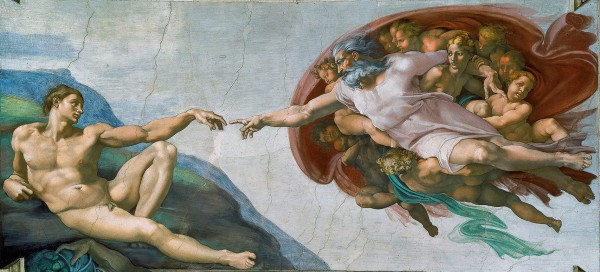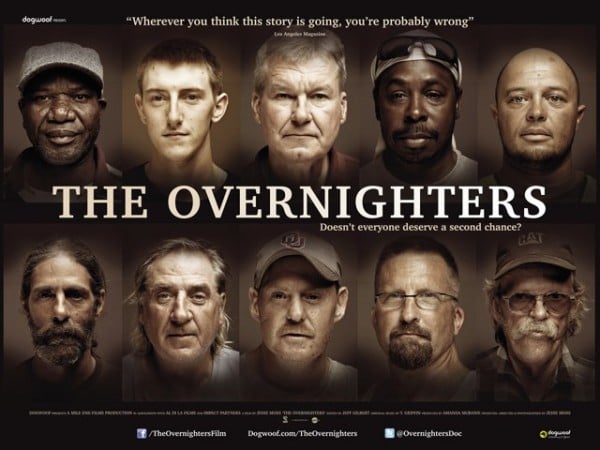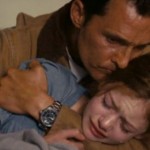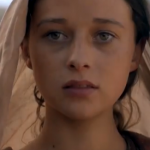If you look closely at the image of God bringing life to Adam in the Sistine Chapel ceiling painting by Michelangelo, you’ll see the iconic work of art is not Biblically accurate.
Then the Lord God formed a man from the dust of the ground and breathed into his nostrils the breath of life, and the man became a living being. – Genesis 2:7
And yet, the image of God reaching down to touch Adam, rather than breathe into his nostrils, is beautiful and true and touches the soul.
Nor was Rembrandt there at the raising of Jesus’s cross, although he painted himself into the scene in Raising of the Cross, as Jonathan Merritt points out over at RNS. His painting is not merely a retelling of the factual story but a theological statement.
Which brings us to Darren Aronofsky’s Noah, a work of art in film and a theological exploration of the ways of God and man, the likes of which have not been seen on the big screen since No Country for Old Men or The Tree of Life.
Anyone hoping to see merely an accurate portrayal of the few verses in Genesis is thinking too small. The movie is much bigger, much richer, and much more exciting than that.
It’s the kind of movie that Christians, indeed everyone, should want Hollywood to make.
Darren Aronofsky has breathed fresh life into a treasured story and made it a story everyone can enjoy and everyone can ponder.
The action starts in a predeluvian world, somewhere between the Garden of Eden and present day. In style, it’s a little bit Braveheart and a little bit Lord of the Rings. Noah, his wife, and his sons live gentle lives, at peace with man and nature. They take what they need and do their best to avoid the rest of mankind, those who would take not only what they need, but take from others as well, by force.
There’s a mystical quality to this early earth: Anthony Hopkins plays Methuselah, Noah’s grandfather and the oldest recorded man in the Bible. He is wise, very wise, and a conduit for the Creator’s mystical power. Other beings also roam this early earth. They are the nephilim, heavenly creatures entrapped on the barren planet.
The family of Noah stand alone in a humanity that has horribly, terribly lost its way. They value life. Mankind considers it cheap. They value kindness and respect. Mankind honors only strength and power.
It’s not so different, at its core, than our world now.
Except that Noah has disturbing visions. He knows the Creator is speaking to him, and the message is anything but gentle: Mankind has contaminated creation. Mankind has violated everything: Earth, animals, spiritual beings, each other.
It’s time to put a stop to it. God is going to send a flood. And Noah had better get ready. He is to build a refuge for the innocents, the animals. How can he restore the earth when he can’t perfect his love of his own family, especially his son Ham (Logan Lerman)?
Russell Crowe does a wonderful job as Noah, a decent man tasked with a huge burden. He is tortured, yes, but resolute. Jennifer Connelly, equally resolute, becomes a lovely voice of mercy in an increasingly dark story. Emma Watson, as Noah’s adopted daughter, has a surprisingly large role. She is occasionally overwrought, but still a fine actor.
Darren Aronofsky has proven himself a lyrical director in the past and this movie is no different. The images are stunning at times: when the Creator provides a forest in a wasteland with which to build the ark it not only moves the plot along but conjures images of life versus desolation, renewal versus devastation, the water of life. When the rain pours and the deeps open and the waves crash, the film recalls great art such as the woodcarvings of Gustave Doré: dark, desperate bodies writing on rocks.
For all the grief that has preceded this movie, there is no softening of the central story as often happens in Christian depictions of it. The flood is not regional, not muted, not filled with smiling animals and sunny skies. It is a cataclysmic event. It is exciting and dreadful and total.
The biggest surprise of the movie, besides Noah’s dark inner conflict, comes in the person of Tubal-Cain (Ray Winstone), a tribal leader determined to survive the flood by force of will. “I am man made in Your image,” he cries to the Creator as he sharpens a sword for battle, “Why do you not converse with me?”
He goes on: “I give life. I take life away. I am like You, am I not?” This man, this personification of the wickedness of humanity, believes in the Creator but will have his own way. He will control his own destiny.
He is not unlike Satan in Paradise Lost.
This is heady stuff for an action movie, and action movie it is, what with all the crashing waves and clanging swords.
I was never bored in this film. I was never embarrassed because it became too corny or trite or simplistic or unprofessional. Both those happen in Christian subculture movies. But this isn’t a Christian subculture movie. It’s a mainstream movie with deep theological themes.
It is just a good movie, a good movie made for everyone, that happens to be based on a Bible story.
Rated PG-13, the film has clean language and no overt sexuality, although one storyline does involve a pregnancy. The violence is not gory. The hardest thing about this film for kids is the dark thematic material: God destroying humanity. There are plenty of images of death, both in visions and in the action. This may be very disturbing for some youngsters and is a good reason to limit the viewing to teens.
The film differs from religious movies we all know in that the viewer doesn’t feel browbeaten at the end, forced to either accept or reject some theological point of contention. Rather, it opens questions and lets them linger. For all its talk of Creator, creation, and sin, it never preaches.
Ultimately, the movie explores hope versus despair, mercy in tension with justice, second beginnings. It is dark, but the darkness makes the clearing skies all the more lovely. It is a work of art and one that I recommend seeing, for believers and nonbelievers alike.


















